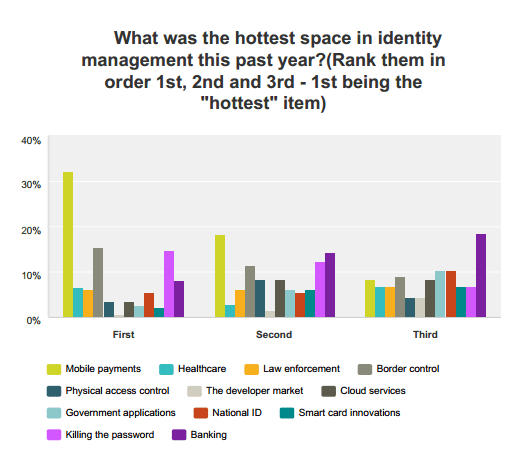In December, FindBiometrics published the results of our 12th annual identity management industry Year in Review survey. This year we endeavored to involve as many biometrics experts and professionals as possible. The result: over 150 responses from a diverse sample of industry voices helping us paint a picture of what 2014 was like in the world of biometrics.
Throughout January we are going to take a closer look at the responses to our survey starting with the first one:

Payments Versus Banking
It should not come as a surprise that mobile payments took the top spot in the section of the survey. As mentioned in the initial release, payments and biometrics were in the news for the entirety of the year, with real deployments ending up in the hands of end users around the world. What’s more is that as the year progressed the biometric payments news seemed to grow in magnitude.
In February the starter’s pistol went off when PayPal announced its support for the Samsung Galaxy S5 sensor, in September Apple Pay was announced as was the biometric payment support from Alipay, and as the year started to wrap up we learned about the upcoming Zwipe biometric MasterCard and Nymi’s biometric payment enabling wearable tech.
Unable to keep up with this breakneck pace of proliferation was the realm of mobile biometric banking. Where, in the past, the idea of biometric commerce was enough to encapsulate the ideas of both banking and payment, in 2014 it became very clear that these are two distinctly separate areas of application.
That’s not to say biometric banking was inactive in 2014. Barclays made the news with its rolling out of finger vein readers for its corporate customers to use for online authentication, and voiceprints have been integrated into phone banking enough to cause some alarmists to panic. Banks and financial institutions also partnered with biometrics companies in 2014, posturing for what seems to be a big change on the horizon in terms of post-PIN and password banking.
Border Control
Border control is another topic that’s been in the news all year in a favorable manner. Right out of the gate, rosy predictions for the automated border control (ABC) markets painted a picture of biometric solutions seeing an increased period of adoption, particularly in Europe, which is expected to dominate the ABC eGates and Kiosks market between now and 2020.
Deployments and pre-screening initiatives rolled out in an effort to make travel – particularly by plane – much more convenient and secure. That said, the developments in 2014 seem to be the early stages of something bigger, and problems still need to be addressed, like what the IBIA calls the unfulfilled mandate of biometric exit.
In the end, the past year was encouraging in terms of biometric border control. The huge demand for ABC and APC solutions is reason not just for government and industry professionals to get excited but also for frequent travelers to be hopeful that they will one day soon see a truly dignified, convenient and secure airport screening experience.
Killing The Password
Logical access control is changing in a major way. We in the biometrics industry have known this for a long time, but after 2014 this fact is finally becoming widely accepted.
The need for post-password security has been around for a long time, but highly publicized security incidents, including the recent Sony breach and the targeted celebrity hack that ended up leaking personal private property, the average user is starting to have an idea of how unsafe their favorite secret eight digits are.
What’s more: in 2014 users of all kinds have been given access to an increasingly accessible selection of strong authentication based password alternatives. This is especially true in the realm of smartphones and tablets, with embedded fingerprint sensors becoming all but standard on new flagship models from all around the world.
Further underlining 2014 as the year of password death was the major milestone achieved by the FIDO Alliance, which published the final 1.0 drafts of both its UAF and U2F specifications for online authentication.
The Hot, The Warm and The Cold
The rest of the categories were much more neck-and-neck, sticking to a pretty close baseline. Healthcare and law enforcement verticals seem a little hotter than average, while cloud services, physical access control, government and smart cards categories follow.
Firmly in place as the coolest item on the spectrum of hot industry spaces is the developer market.
*
Stay posted to FindBiometrics throughout January as we continue to examine our 12th annual Year in Review. Join the conversation by following us on Twitter and telling us how your year was in biometrics by using the hashtag #FBYearInReview.
—
January 7, 2015 – by Peter B. Counter


Follow Us